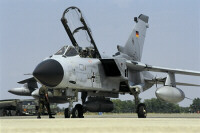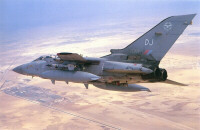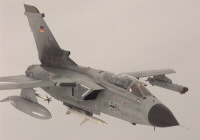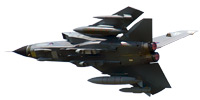Panavia Tornado
Role: ground-attack/strike/recce/SEAD (IDS/ECR), interceptor (ADV)
Builder: Panavia (BAe, DASA, Alenia)
Variants: IDS/IDS-T (GR.1/GR.1A/GR.1B, GR.4/GR.4A), ECR, ADV (F.2, F.3)
Operators: United Kingdom, Germany, Italy, Saudi Aradia
The Tornado resulted from a collaboration between the United Kingdom, Germany, and Italy for a single aircraft design to meet the needs of each of the nations' air forces. Dubbed the MRCA (Multi-Role Combat Aircraft), the development was undertaken by Panavia, a consortium of British Aerospace, Germany's DASA, and Italy's Alenia. The PA-200 two-seat design with variable swept wings was selected and the first variant of the MRCA would fulfil the urgent need for a modern fighter-bomber.
Interdiction/Strike
The Tornado IDS was the first production type following the MRCA prototype. The IDS (interdictor/strike) variant is a true strike aircraft specialised at high speed low level flight thanks to its variable wings and terrain following radar. Advanced in computer technology at the team resulted in a navigation/attack system that greatly improved the accuracy of air strikes over the Tornado's predecessors. A number of aircraft were built with dual controls for conversion training (IDS-T). In Italy/Germany the Tornado IDS was still referred to as PA-200, while the Royal Air Force gave it the Tornado GR.1 designation.
While the development, production and also pilot training were a tri-national effort, the final assembly of the aircraft was undertaken by each of the nation's own industries. Further weapon and equipment fits, modifications, and upgrades were also largely subject to each of the air forces' needs.
The Royal Air Force also had dedicated GR.1A reconnaissance versions, and designated aircraft capable of deploying the Sea Eagle anti-ship missile the Tornado GR.1B.
Air Defence Variant
The Tornado ADV was developed by the United Kingdom for the air defence role, primarily as an interceptor with look-down shoot-down capability to counter the threat of Soviet bombers and their escorts. Upgraded RB.199-34R Mk.104 engines were fitted with better performance for long high altitude flight than the previous Mk.103. The ADV received a redesigned nose to accommodate the Foxhunter intercept radar. Its main weapon was the Skyflash semi-active medium range air-to-air missile, four missiles could be carried semi-recessed under the fuselage. The initial ADV version was designated F.2 and a first batch entered service with limited capability. The F.2 was soon superseded by the Tornado F.3, which featured a longer fuselage increasing internal fuel. Additionally, larger supersonic fuel tanks were developed to extend the range.
Italy leased a number of Tornado ADV aircraft from the UK as interim solution for air defence.
Electronic Combat and Reconnaissance
The ECR (electronic combat and reconnaissance) version was a Tornado variant developed by
the Germans for the electronic reconnaissance role and suppression/destruction of enemy air defence with the AGM-88A HARM
anti-radar missile. Also Italy procured a number of ECR versions.
The Royal Air Force did not have a dedicated electronic warfare version of the Tornado, but the ALARM missile was integrated
on the Tornado GR.1.
Exports
Saudi Arabia was the only export customer for the Tornado, ordering both the Tornado IDS and Tornado ADV from the United Kingdom.
Mid-Life Upgrades
While the MRCA program produced an airframe suitable for multiple roles, the resulting aircraft were each dedicated to a specific role. In a world of more versatile multi-role aircraft the Tornado has soldiered on thanks to various upgrades making it more versatile in the strike role, albeit with fleets counting much reduced numbers. Each of the nation's remaining Tornado fleets have been or are being put through a mid-life upgrade program.
The Royal Air Force (RAF) was the first operator to put its Tornado fleet through an life extension upgrade. Part of the Tornado GR.1/A/B fleet was upgraded
to GR.4 with the reconnaissance version being GR.4A (-B was dropped as the GR.4 would be capable of deploying the Sea Eagle missile, it was later retired).
More recently, the Tornado GR.4 fleet also received various new sensors and weapons added for Urgent Operational Requirement purposes, these include the Storm Shadow
stand-off air-to-surface cruise missile, LD/TGP pod and new guided weapons, Brimstone air-to-ground missiles and the RAPTOR reconnaissance pod. The latter replaces
the Tornado GR.4A's internal recce suite. The RAF plans to retire the Tornado GR.4 in 2019, but force reduction is stepped up in light of reduced defence budget, and
while the Eurofighter Typhoon gains air-to-ground capabilities.
The Royal Saudi Air Force remaining
Tornado IDS aircraft received a similar life extension upgrade as the RAF Tornado GR.4 fleet, also adding modern sensors and weapons.
The Royal Air Force Tornado F.3 fleet however was retired earlier than the strike version with the advent of the Eurofighter Typhoon. While the Tornado F.3 was a capable interceptor, the Tornado would never be able to compete in air combat. However in the twilight of its career, replacing the semi-active SkyFlash the AIM-120 AMRAAM missile could finally be fired thanks to data-linking with a sensor aircraft such as the Sentry AWACS. Also the ASRAAM agile short-range missile replaced the older AIM-9 Sidewinder. A plan to add the ALARM missile to have the Tornado F.3 operate in the SEAD role using its Emitter Locator System, that was superior compared to the Tornado GR.4, remained unfunded. The last Tornado F.3 were retired in early 2011.
Germany's Mid Life Update (MLU) for the Tornado is in progress. Although the German Tornado fleet has been cut from 185 to 85 aircraft, the German Air Force (Luftwaffe) intends to keep the type in service until beyond 2025. The German Navy's Marineflieger has retired the aircraft, most of which were redirected to the Luftwaffe. The German Tornados had already received a number of smaller updates over the years, including integrating a reconnaissance pod on part of the Tornado IDS fleet. The Mid Life Update carried out by Cassidian however aims to truly expand the Tornado's roles. The software-driven update process named Avionics System Software Tornado Ada (ASSTA) introduces new capabilities by integrating new systems and weapons. With ASSTA 3 German Tornados will also be able to operate in network-centric warfare adding MIDS Link16, and deploy the latest precision guided munitions. The update will end the distinction between the IDS/RECCE, and the ECR in terms of roles, as all aircraft will be able to carry out most roles (the ECR will however not get the 23mm cannon).
Also the Italian Air Force (AMI) Tornado IDS and ECR fleet has been put through a mid life update, carried out primarily by Alenia. The Italian MLU program knows three standards, RET 6, 7 and 8, with the latter being the full upgrade. 18 IDS aircraft received the RET 6 initial upgrade of navigation and communication systems, and integration of new weapons. 15 IDS aircraft, including three IDS-T, were upgraded to RET 7 standard which also involved structural life extension work and basic integration with the RecceLite pod. The final batch of 25 aircraft, including 15 ECR variants, the full upgrade; RET 8. RET 8 also introduces improved displays with NVG compatibility, full integration with RecceLite, MIDS Link16, the AGM-88E ARM and GBU-39 SDB. The MLU will enable the Tornado to stay in Italian Air Force service until 2025 or beyond, but with the breakdown in three tranches it's likely this only applies to the 25 RET 8 aircraft and some of the RET 7 aircraft rather than the full fleet of 58.

Luftwaffe Tornado IDS

RAF Tornado F.3 ADV

Luftwaffe Tornado ECR


 Back to Index
Back to Index